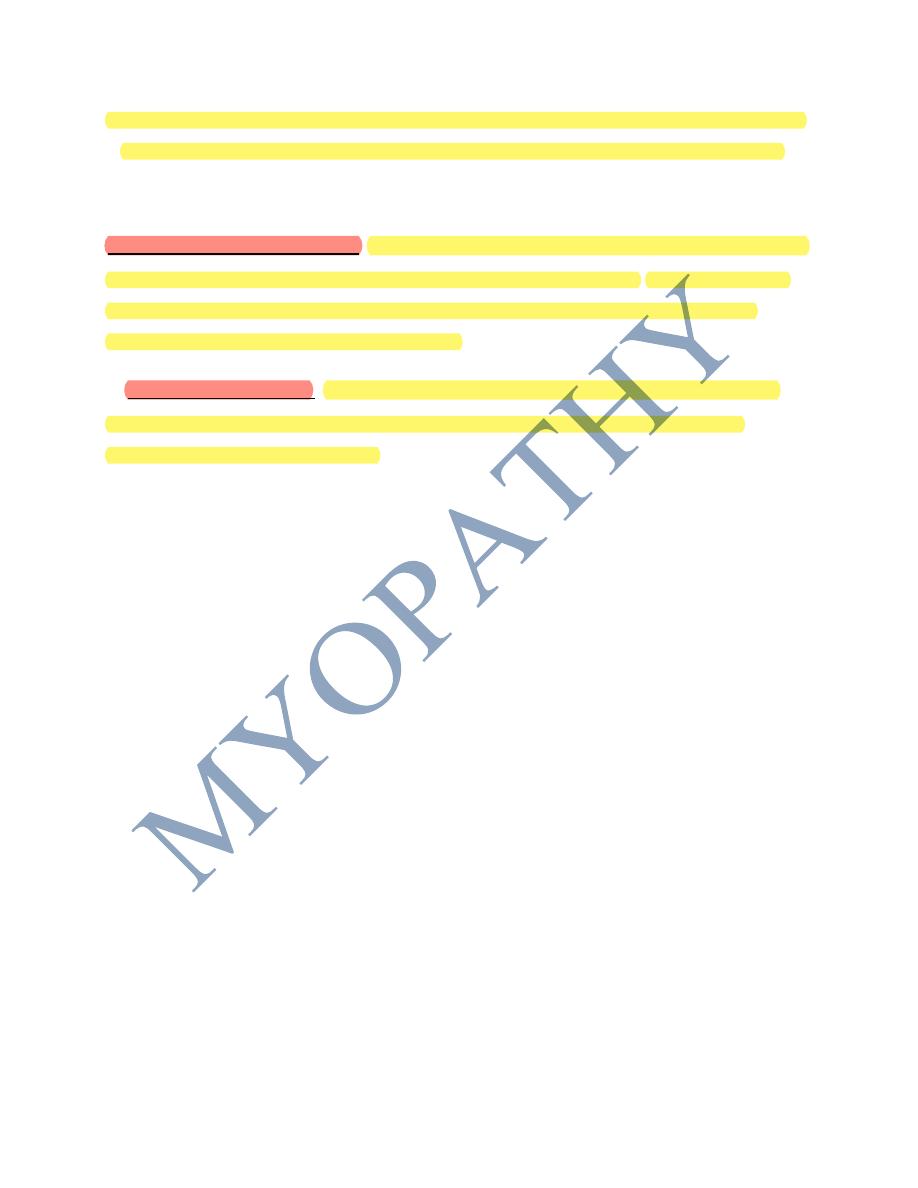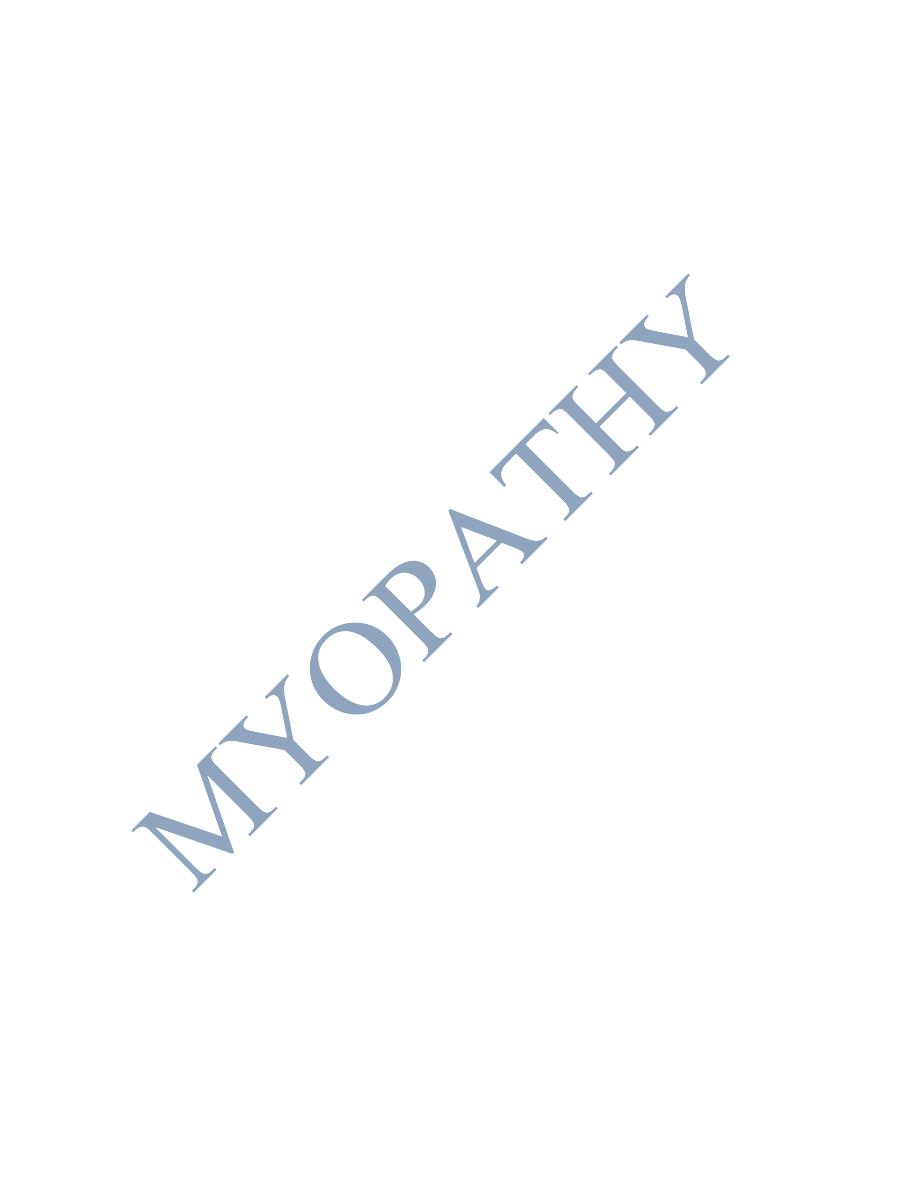
1
MYOPATHIES
Limb girdle muscular dystrophy
Autosomal dominant or recessive, presents during childhood or early adulthood. It
typically manifests with progressive weakness of pelvic and shoulder girdle musculature.
Some have calf hypertrophy. Some have cardiac conduction abnormalities.
Facioscapulohumeral (FSH)
Autosomal dominant, characterised by facial and upper limbs weakness, there is
bilateral scapular winging when the patient pushes against a wall.
INHERITED METABOLIC MYOPATHIES
A large number of individually rare inherited disorders of the biochemical pathways
necessary to maintain the supply of chemical energy (ATP) in muscles may present with
muscle pain, weakness and fatigue. These are mostly recessively inherited deficiencies
in the enzymes of the glycolytic and fatty acid metabolism pathways. They are
characterised by exercise-induced muscle cramps, myoglobinuria. The most common
type is glycolytic disorder affecting the myophosphorylase enzyme, called (McArdle's
disease).

2
CHANNELOPATHIES (periodic paralysis)
1-Hypokalemic periodic paralysis
It is an autosomal dominant condition, from mutations in the muscle calcium-channel. It
is the most frequent form of periodic paralysis, is more common in males.
Attacks begin
by adolescence (less than 20years) and are aggravated by exercise, sleep, stress,
alcohol, or meals rich in carbohydrates and sodium.
Weakness may take as long as
24 h to resolve. A vague prodrome of stiffness or heaviness in the legs can occur, followed
by limbs weakness. Patients have normal interictal examination findings. Investigations
include ECG and serum potassium. Thyroid function test may also be done because
attacks of thyrotoxic periodic paralysis resemble those of hypokalemic periodic paralysis.
TREATMENT:
a-The acute paralysis improves after the administration of potassium. Muscle strength
and ECG should be monitored. Oral KCl (0.2
–0.4 mmol/kg) should be given every 30
min or IV KCl (40-80 mmol/24hr.) given in mannitol.
b- Preventive measures include a low-carbohydrate, low-sodium diet and avoidance of
intense exercise, prophylactic drugs such as acetazolamide (125
–1000 mg/d in divided
doses) spironolactone (25
–100 mg/d), or triamterene (25–100 mg/d).
2-
Hyperkalemic periodic paralysis:
sodium channel disorder
It is characterized by attacks of limbs weakness lasting 1 or 2 hours.
Attacks are
precipitated by fasting, by rest after exercise, or by ingestion of potassium-rich foods or
compounds.
The serum potassium level may or may not be increased during the attack,
and therefore a more appropriate term may be potassium-sensitive periodic paralysis.
Strength is generally normal between attacks. Treatment options to prevent attacks

3
include acetazolamide, th
iazide diuretics, ß-agonists, and preventive measures such as
a low-potassium, high-carbohydrate diet and avoidance of fasting, strenuous activity.
3-Paramyotonia congenita:
sodium channel disorder, characterised by paradoxical
myotonia in that the myotonia increases with repetitive movements; for example, after
several attempts to close the eyelids, patients cannot open their eyelids. Episodic
weakness is provoked by exercise and cold.
4-
Myotonia congenita:
chloride channel disorders, characterised by generalised
myotonia with muscle hypertrophy. Myotonia is reduced gradually with repeated
exercise, and aggravated by cold.
Endocrine and metabolic myopathies
• Hypothyroidism
• Hyperthyroidism
• Acromegaly
• Cushing's syndrome (including iatrogenic)
• Addison's disease
• Conn's syndrome
• Osteomalacia
• Hypokalaemia (liquorice, diuretic and purgative abuse)
• Hypercalcaemia (disseminated bony metastases)

4
Drug and toxic myopathies
•
Alcohol (chronic and acute syndromes)
•
Vitamin E
•
Organophosphates
•
Corticosteroids (especially fluorinated)
•
β-blockers
•
Statins
•
Clofibrate
•
Ciclosporin
•
Zidovudine
•
Opiates
